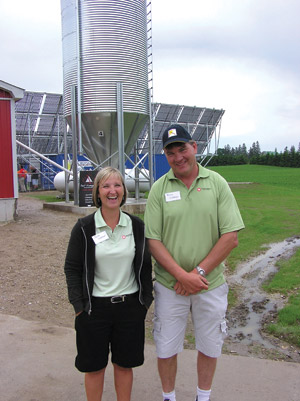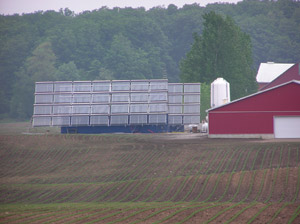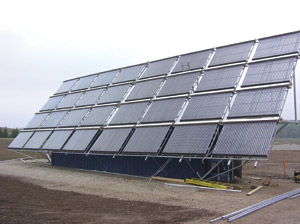
Solar Savings: Tired of rising energy costs, the Lidners are utilizing solar power
Jim Knisley
Features Bird Management ProductionTired of rising energy costs, the Lidners are utilizing solar power
With propane costs soaring, Bruce Lidner knew something had to be done. After investigating the alternatives the broiler producer from near
Amulree, Ont., northeast of Stratford, decided to tap the sun to help
heat his barns.

|
| Bruce and Jane Lidner of Amulree, Ont., are the first poultry farmers to install this specially designed system, which provides a cost-effective and environmentally friendly source of heat. |
With propane costs soaring, Bruce Lidner knew something had to be done.
After investigating the alternatives the broiler producer from near Amulree, Ont., northeast of Stratford, decided to tap the sun to help heat his barns.
After looking at photovoltaic systems, which generate electricity, he opted for a system from Copperhill Solar of Norwood, Ont., that uses the sun to produce hot water that will be utilized to heat his barns.
Lidner said he expects to save about $20,000 annually on his heating costs after installing a $320,000 solar heating system.
“I was just tired of paying the propane bills,” he said.
Not only was he tired of paying the bills as they were – about $60,000 a year – he really didn’t want to face what was coming. The cost of propane has soared this year and there is no end in sight for the increases.
When Bruce and his wife Jane took over the operation from his parents in 1991 propane cost about 18 or 19 cents a litre. In June it was about 52 cents a litre and looked like it would be even more expensive this winter.
It was absolutely clear to Lidner that “we’ve got to start doing something different.”
A key factor in his decision was a federal/provincial program that refunds 50 per cent (25 per cent from each level of government) of the cost of the system. With the money from the programs factored in, the solar heating system will pay for itself in eight years.
Lidner’s solar system is designed by Copperhill Solar and it isn’t what most people think of when they think solar.
It consists of two large banks of south facing panels installed next to a new, well-insulated 17,000-square-foot barn that had floor heating installed when constructed last fall.
The panels are made up of multilayered evacuated vertical glass tubes and a thin copper tube containing a small bit of fluid.
The heat from the sun is captured by the tubes and the fluid is superheated. The copper tube then heats a mixture of food-grade antifreeze and water in a manifold. The heated water and antifreeze flows to copper coils immersed in a water tank. The coils heat the water in the tank that is in a heavily insulated shipping container located behind the panels. From there, the water is pumped into the barn.

|
| Copperhill Solar designed two large banks of south facing panels installed next to a new, well-insulated 17,000-square-foot barn that has floor heating installed on the Lidner farm. |
Lidner is also using the system to heat an older nearby barn. The older barn doesn’t have a floor-heating system but it will be a simple matter to move the heated water through wall-mounted pipes.
John Verway, president of Copperhill Solar, said the panel system was designed by his company and has come through three years of testing by the Canadian Standards Association (CSA) and Bodycote, a worldwide company with 245 testing facilities.
Verway also said that patents for the industrial design and for the control panels that are part of the system are pending.
The Lidner farm is the first for Copperhill in southwestern Ontario, but the company has customers in 32 Canadian cities from Kingston to Calgary. Copperhill has distributors across Canada and all are rigorously screened. The distributors also install and try out the system on their own buildings or homes to ensure that they know how it works and how effective it is, Verway said.
The Lidner farm is also the first poultry operation to use the Copperhill System, but Verway sees lots of potential.
So long as the government programs continue to support the installation of solar systems – the programs could expire or be changed in September – the system is a source of extremely cost-effective, environmentally friendly heat. It can be mounted on roofs as well as steel supported stand-alone units like those on the Lidner farm.
While the system is extremely efficient, it, like any solar system, works best when the sun is shining. For very cold, cloudy days the existing propane system will be automatically activated to provide heat.
To accomplish this the Copperhill controls include sensors that will say when water from the solar system is hot enough and the propane burners can be shut down. If the water isn’t hot enough the propane system will be activated.
The controls are located in the shipping containers behind the solar panels and work with the existing controls in the barn itself.
Lidner also likes the look of the solar panels saying that he finds them attractive.
The system consists of 60 panels of 32 tubes each for a total of 1,920 tubes. Each tube is about 2.5 inches in diameter and five feet long and each panel is about 7.5 feet wide and 5.5 feet high.
It is estimated that a 60-panel system, like Lidner installed, would save more than $34,000 in electricity or almost $20,000 in oil.
Verway says the system can recover up to 48 per cent of solar energy as compared with 14 per cent with solar panels that generate electricity.

|
Lidner also found an added benefit to the in-floor heating system in his new barn.
He has found that he can dispense with straw for the 11,000 broilers in that barn, placing them directly on concrete. He said the heated floor dries the manure quickly and effectively and the birds are comfortable. His productivity is up, mortality down and humidity levels have been lowered, which has reduced the length of time his fans run and saved electricity.
It also means cleanup is quicker and easier.
“It’s working great,” he said.
The solar heating system was installed by Calvin Ische Plumbing and Heating of Stratford, one of 14 distributors for Copperhill who are located from Kingston to Calgary.
Print this page